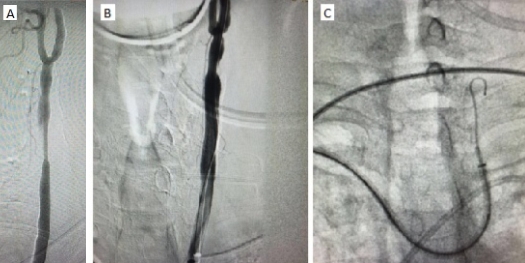A Case of Hybrid Carotid Revascularization
Abstract
Carotid stenosis or occlusion as a cause of stroke has been more difficult to determine. Cerebral infarction attributed to ECVD (Extracranial carotid and vertebral artery disease) was defined as clinical stroke with evidence of infarction on brain imaging associated with >60% stenosis or occlusion of an extracranial carotid or vertebral artery documented by noninvasive imaging or angiography. Radiation to the neck poses a high risk for developing carotid stenosis. Even though the standard treatment for extracranial artery stenosis is CEA (Carotid endarterectomy), higher rates of CNI (Cranial Nerve Injury) and wound complications including infection limit CEA applications in patients with prior radiation. CAS (Carotid angioplasty and stenting) should be considered as an alternative to CEA for those patients with high surgical risk.ÂReferences
1.Brott T G, Halperin J L, Abbara S. et al. ASA/ACCF/AHA/AANN/AANS/ACR/ASNR/CNS/SAIP/SCAI/SIR/SNIS/SVM/SVS guideline on the management of patients with extracranial carotid and vertebral artery disease: executive summary. A report of the American College of Cardiology Foundation/American Heart Association Task Force on Practice Guidelines, and the American Stroke Association, American Association of Neuroscience Nurses, American Association of Neurological Surgeons, American College of Radiology, American Society of Neuroradiology, Congress of Neurological Surgeons, Society of Atherosclerosis Imaging and Prevention, Society for Cardiovascular Angiography and Interventions, Society of Interventional Radiology, Society of NeuroInterventional Surgery, Society for Vascular Medicine, and Society for Vascular Surgery. Circulation. 2011;2011;124:489–532.
2.Mantese VA, Timaran CH, Chiu D, Begg RJ, Brott TG. The Carotid Revascularization Endarterectomy versus Stenting Trial (CREST) - Stenting versus Carotid Endarterectomy for Carotid Disease. Stroke; a journal of cerebral circulation. 2010;41(10 Suppl):S31-S34.
3.Fine-Edelstein JS, Wolf PA, O’Leary DH, et al. Precursors of extracranial carotid atherosclerosis in the Framingham Study. Neurology.1994;44:1046 –50.
4.O’Leary DH, Polak JF, Kronmal RA, et al. Distribution and correlates of sonographically detected carotid artery disease in the Cardiovascular Health Study: the CHS Collaborative Research Group. Stroke. 1992;23:1752– 60.
5.Chambless LE, Folsom AR, Clegg LX, et al. Carotid wall thickness is predictive of incident clinical stroke: the Atherosclerosis Risk in Communities (ARIC) study. Am J Epidemiol. 2000;151:478–87.
6.Lam WW, Leung SF, So NM, Wong KS, Liu KH, Ku PK, Yuen HY, Metreweli C: Incidence of carotid stenosis in nasopharyngeal carcinoma patients after radiotherapy. Cancer 2001; 92: 2357–2363.
7.Abayomi OK: Neck irradiation, carotid injury and its consequences. Oral Oncol 2004; 40: 872–878.
8.Murros KE, Toole JF: The effect of radiation on carotid arteries. A review article. Arch Neurol 1989; 46: 449–455.
9.Immediate and Late Clinical Outcomes of Carotid Artery Stenting in Patients with Symptomatic and Asymptomatic Carotid Artery Stenosis. A 5-Year Prospective Analysis, Gary S. Roubin, MD, PhD et al. 2001 by American Heart Association.
2.Mantese VA, Timaran CH, Chiu D, Begg RJ, Brott TG. The Carotid Revascularization Endarterectomy versus Stenting Trial (CREST) - Stenting versus Carotid Endarterectomy for Carotid Disease. Stroke; a journal of cerebral circulation. 2010;41(10 Suppl):S31-S34.
3.Fine-Edelstein JS, Wolf PA, O’Leary DH, et al. Precursors of extracranial carotid atherosclerosis in the Framingham Study. Neurology.1994;44:1046 –50.
4.O’Leary DH, Polak JF, Kronmal RA, et al. Distribution and correlates of sonographically detected carotid artery disease in the Cardiovascular Health Study: the CHS Collaborative Research Group. Stroke. 1992;23:1752– 60.
5.Chambless LE, Folsom AR, Clegg LX, et al. Carotid wall thickness is predictive of incident clinical stroke: the Atherosclerosis Risk in Communities (ARIC) study. Am J Epidemiol. 2000;151:478–87.
6.Lam WW, Leung SF, So NM, Wong KS, Liu KH, Ku PK, Yuen HY, Metreweli C: Incidence of carotid stenosis in nasopharyngeal carcinoma patients after radiotherapy. Cancer 2001; 92: 2357–2363.
7.Abayomi OK: Neck irradiation, carotid injury and its consequences. Oral Oncol 2004; 40: 872–878.
8.Murros KE, Toole JF: The effect of radiation on carotid arteries. A review article. Arch Neurol 1989; 46: 449–455.
9.Immediate and Late Clinical Outcomes of Carotid Artery Stenting in Patients with Symptomatic and Asymptomatic Carotid Artery Stenosis. A 5-Year Prospective Analysis, Gary S. Roubin, MD, PhD et al. 2001 by American Heart Association.

